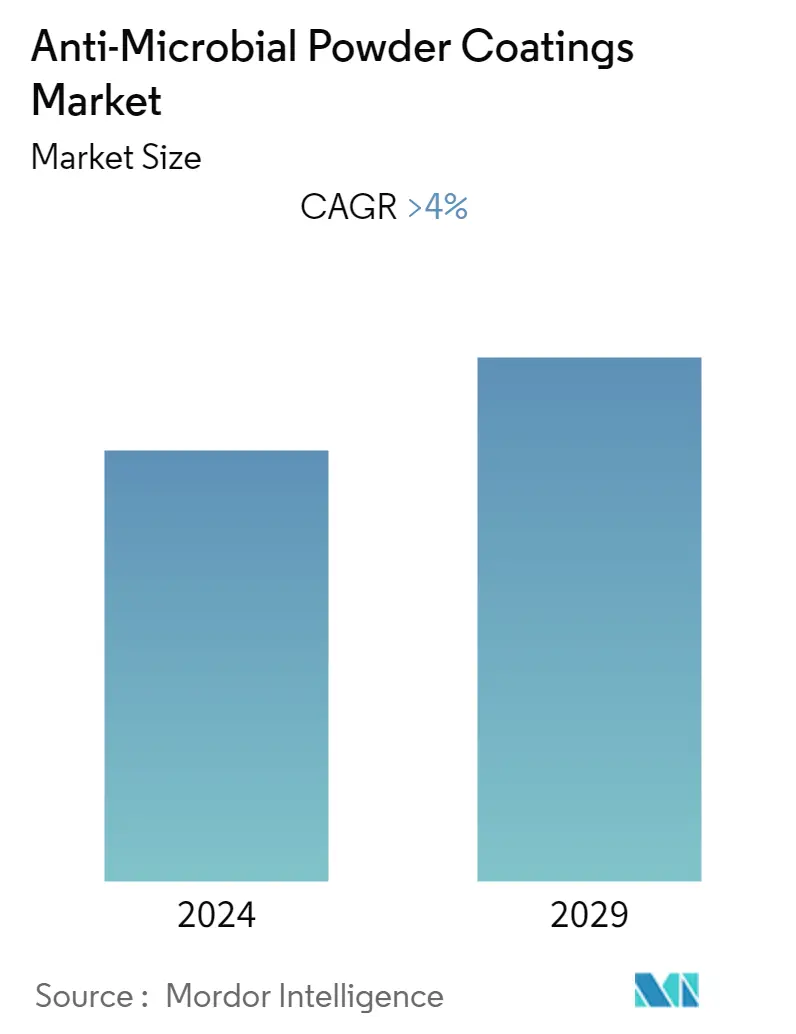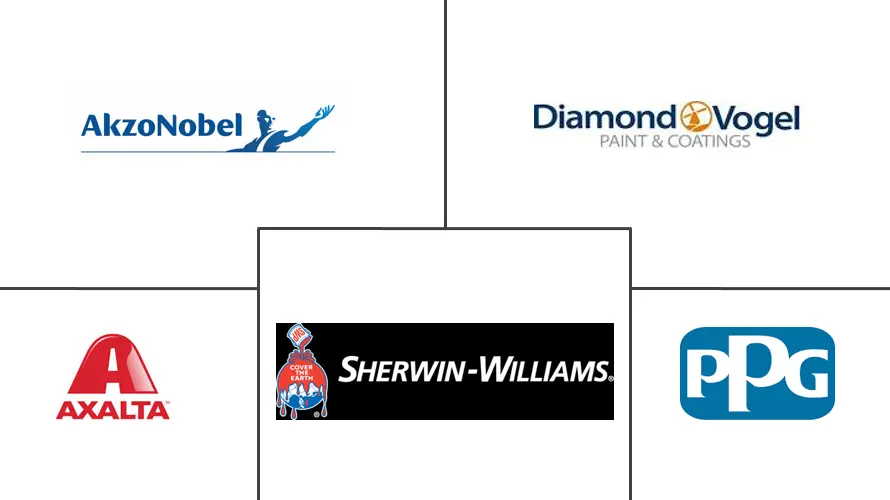Market Size of Anti-Microbial Powder Coatings Industry

| Study Period | 2019 - 2029 |
| Base Year For Estimation | 2023 |
| Forecast Data Period | 2024 - 2029 |
| CAGR | > 4.00 % |
| Fastest Growing Market | North America |
| Largest Market | North America |
Major Players
*Disclaimer: Major Players sorted in no particular order |
Anti-Microbial Powder Coatings Market Analysis
The market for Global Anti-Microbial Powder Coatings is expected to grow at a CAGR of more than 4% during the forecast period.
- Increasing demand from the indoor air quality systems combined with the need for VOC free coatings is expected to drive the Anti-Microbial Powder Coatings market.
- North America is estimated to dominate the market with the largest consumption coming from the United States
Anti-Microbial Powder Coatings Industry Segmentation
The Anti-Microbial Powder Coatings Market report include:
| By Type | |||||
| |||||
| Organic | |||||
| Natural |
| By End-User Industry | |
| Healthcare | |
| Textiles | |
| Electrical and Electronics | |
| Food & Beverages | |
| Building & Construction | |
| Others |
| Geography | |||||||
| |||||||
| |||||||
| |||||||
| |||||||
|
Anti-Microbial Powder Coatings Market Size Summary
The global anti-microbial powder coatings market is poised for significant growth, driven by increasing demand for VOC-free coatings and enhanced indoor air quality systems. These coatings, which protect surfaces from microorganisms like fungi and bacteria, offer advantages such as high strength, corrosion resistance, and durability. Unlike liquid coatings, they do not require binders in a liquid suspension form or solvents, making them a more efficient option. The market is segmented into natural, organic, and inorganic materials, with inorganic materials like silver and copper expected to dominate due to their higher efficiency. Silver coatings, in particular, are favored for their biocompatibility, and regulatory approvals in the United States have facilitated their inclusion in product portfolios, boosting the inorganic segment in North America.
North America leads the global demand for anti-microbial powder coatings, largely due to their application in the healthcare and food preservation sectors. The United States, as the largest medical device market, drives this demand with its focus on hygiene and infection control, especially given the aging population and rising chronic disease cases. The coatings are increasingly used in public and high-traffic areas to prevent the spread of pathogens, further fueling market growth. The market is partially consolidated, with key players such as AkzoNobel NV, Diamond Vogel Paints, Axalta Coating Systems, The Sherwin-Williams Company, and PPG Industries Inc. playing significant roles in shaping the industry's landscape.
Anti-Microbial Powder Coatings Market Size - Table of Contents
-
1. MARKET DYNAMICS
-
1.1 Drivers
-
1.1.1 Growing demand from the indoor air quality systems
-
1.1.2 Demand for the VOC(Volatile Organic Compound) free coatings
-
1.1.3 Other Drivers
-
-
1.2 Restraints
-
1.2.1 Impact of COVID-19 Outbreak
-
1.2.2 Other Restrains
-
-
1.3 Industry Value-Chain Analysis
-
1.4 Porter's Five Forces Analysis
-
1.4.1 Bargaining Power of Suppliers
-
1.4.2 Bargaining Power of Consumers
-
1.4.3 Threat of New Entrants
-
1.4.4 Threat of Substitute Products and Services
-
1.4.5 Degree of Competition
-
-
-
2. MARKET SEGMENTATION
-
2.1 By Type
-
2.1.1 Inorganic
-
2.1.1.1 Silver
-
2.1.1.2 Copper
-
2.1.1.3 Heavy Metals
-
-
2.1.2 Organic
-
2.1.3 Natural
-
-
2.2 By End-User Industry
-
2.2.1 Healthcare
-
2.2.2 Textiles
-
2.2.3 Electrical and Electronics
-
2.2.4 Food & Beverages
-
2.2.5 Building & Construction
-
2.2.6 Others
-
-
2.3 Geography
-
2.3.1 Asia-Pacific
-
2.3.1.1 China
-
2.3.1.2 India
-
2.3.1.3 Japan
-
2.3.1.4 South Korea
-
2.3.1.5 Rest of Asia-Pacific
-
-
2.3.2 North America
-
2.3.2.1 United States
-
2.3.2.2 Canada
-
2.3.2.3 Mexico
-
-
2.3.3 Europe
-
2.3.3.1 United Kingdom
-
2.3.3.2 France
-
2.3.3.3 Germany
-
2.3.3.4 Italy
-
2.3.3.5 Rest of Europe
-
-
2.3.4 South America
-
2.3.4.1 Brazil
-
2.3.4.2 Argentina
-
2.3.4.3 Rest of South America
-
-
2.3.5 Middle-East and Africa
-
2.3.5.1 Saudi Arabia
-
2.3.5.2 South Africa
-
2.3.5.3 Rest of Middle-East and Africa
-
-
-
Anti-Microbial Powder Coatings Market Size FAQs
What is the current Anti-Microbial Powder Coatings Market size?
The Anti-Microbial Powder Coatings Market is projected to register a CAGR of greater than 4% during the forecast period (2024-2029)
Who are the key players in Anti-Microbial Powder Coatings Market?
Akzo Nobel NV, Axalta Coating Systems, PPG Industries Inc., The Sherwin-Williams Company and Diamond Vogel are the major companies operating in the Anti-Microbial Powder Coatings Market.

